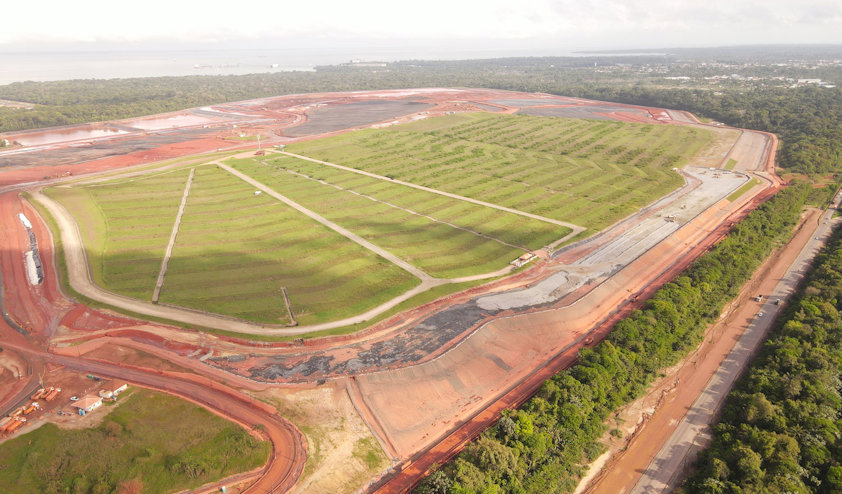Hydro has invested heavily in improved tailings management and state-of-the-art technology for the treatment and disposal of tailings generated from the production of bauxite and alumina in Brazil.
The facilities in Paragominas are dedicated to store tailings from bauxite mining. The tailings undergo a drying cycle that can take 30 to 60 days, during the dry and rainy seasons. After the drying process, the material has a minimum of 60 percent solid content, and is then excavated and deposited back into the mined areas. This method is what Hydro refers to as “Tailings Dry Backfill.”
In Barcarena, the bauxite residue is filter-pressed and stored in dedicated tailings facilities at Hydro’s alumina refinery in Alunorte using an enhanced dry stacking concept. The use of modern press filters results in a bauxite residue with a very low moisture content of 22 percent, which can be more efficiently stored. This new approach means that the residue now occupies only one fourth of the surface area compared to our historical bauxite residue deposit.

How does Hydro manage its tailings facilities?
Hydro’s tailings facilities are operated in line with relevant regulations, regulatory compliance requirements, internal company standards, and the International Council on Mining and Metal (ICMM) framework. At all our tailings facilities, we follow best practice, and audits are conducted by independent third parties. Hydro is committed to implementing the Global Industry Standard on Tailings Management (GISTM), which strives to achieve the goal of zero harm to people and the environment.
You can find more information on how Hydro reinforces the company’s commitment to zero harm, tailings performance and management of the tailings facilities in our annual report and Tailings Management Policy.
What is GISTM?
The Global Industry Standard on Tailings Management (GISTM) is a robust framework developed to enhance the safety, sustainability, and overall management of tailings facilities in the mining industry. GISTM strives to achieve the ultimate goal of zero harm to people and the environment. This is reinforced by an integrated approach to tailings management. The standard aims to prevent catastrophic failure and enhance the safety of mine tailings facilities across the globe. It embodies a step change in terms of transparency, accountability and in safeguarding the rights of people affected by the project.
On August 5, 2020, all ICMM members committed to implementing GISTM at tailings facilities that have a “very high” or “extreme” consequence classification by August 5, 2023. Further, all other tailings facilities operated by members that are not in a state of safe closure should be in conformance with the standard by August 5, 2025.
GISTM in Hydro
Hydro is committed to the responsible management of tailings facilities in alignment with the Global Industry Standard on Tailings Management (GISTM). In line with this commitment, Hydro confirms that all tailings facilities it operates, that are not in a state of safe closure, are in conformance with the GISTM.*
The conformance of Hydro’s four operational tailings facilities in Brazil was assessed and confirmed in 2023. A third party validation was undertaken in 2024 and attested the conformance of all four tailings facilities to GISTM.
In total, Hydro owns 10 tailings facilities. Of these, three closed tailings facilities in Stulln, Germany, have been confirmed as being in a state of safe closure as defined under the GISTM framework during 2024 (Marienschacht) and 2025 (Grube Erna 1 and 2)**.
In June 2025, Hydro’s three closed tailings facilities in Schwandorf, Germany, were assessed and confirmed to be in conformance with GISTM through a self-assessment conducted in accordance with the GISTM Conformance Protocol. A third party validation will be undertaken as soon as reasonably practicable.
Hydro publishes an annual GISTM Public Disclosure Report in accordance with GISTM Requirement 15.1. The most recent report is available here: gistm-public-disclosure-report-2024.pdf
*Hydro acknowledges that implementation and maintenance of the GISTM is an ongoing process of continuous improvement. Conformance assessments represent a specific point in time. Maintaining alignment with the standard will require not only regular review and updating of key documentation, but, more importantly, the systematic execution of activities through Plan–Do–Check–Act processes to ensure adherence in both practice and governance.
**Being in a state of safe closure does not imply abandonment or a walk-away scenario. Rather, it marks a transition from active closure works to long-term post-closure stewardship, governed by established closure plans, applicable legal requirements and Hydro’s internal standards. Monitoring and maintenance will continue as required and may be reduced over time, provided performance data and closure reviews demonstrate that the facility continues to meet performance expectations. The classification of a facility as being in a state of safe closure reflects Hydro’s ongoing commitment to responsible management and oversight. Should Hydro, in the future, consider full relinquishment or formal walk-away status, a separate review and approval process would be initiated, as relinquishment has not been assessed as part of the current safe closure evaluation.
Updated: August 4, 2025
